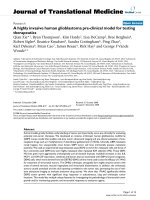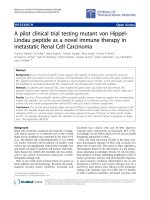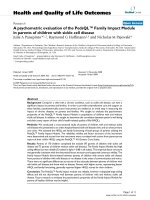báo cáo hóa học:" "A Free thenar flap – A case report" pdf
Bạn đang xem bản rút gọn của tài liệu. Xem và tải ngay bản đầy đủ của tài liệu tại đây (533.38 KB, 3 trang )
BioMed Central
Page 1 of 3
(page number not for citation purposes)
Journal of Orthopaedic Surgery and
Research
Open Access
Case report
"A Free thenar flap – A case report"
Rajesh Garg*, Boris KK Fung, Shew Ping Chow and Wing yuk Ip
Address: Department of Orthopaedic Surgery, Hand and Foot Division, Queen Mary Hospital, University Of Hong Kong, Hong Kong
Email: Rajesh Garg* - ; Boris KK Fung - ; Shew Ping Chow - ;
Wing yuk Ip -
* Corresponding author
Abstract
We present a case report of a free thenar flap surgery done for a volar right hand middle finger,
distal and middle phalanx degloving injury. A free thenar flap is a fasciocutaneous sensate flap
supplied by a constant branch of the superficial radial artery and its variable nerve supply. It has a
distinct advantage of low donor site morbidity, better cosmesis and texture of the flap. No
immobilization is required postop. The donor site can be closed primiarily.
Background
Numerous local or regional flaps have been used to cover
medium to small size volar soft tissue defects of the digit.
Large volar defects over the digit have presented a thera-
peutic challenge to the reconstructive hand surgeon. Free
flaps from the feet or toes have been used to provide sat-
isfactory coverage of these large defects, however donor
site morbidity is unavoidable and the patient's acceptance
is questionable.
We would like to report an alternative method to resurface
a large volar defect of the finger utilizing a free thenar flap.
Case report
A 36 year old man sustained a degloving injury to his
right, middle finger (which he caught in a machine, while
at work) resulting in a large volar soft tissue defect extend-
ing from the tip of the distal phalanx to the mid portion
of the middle phalanx. Bone and part of the profundus
tendon was exposed (Fig. 1). The tip of the distal phalanx
was crushed, without any other bony injury.
A primary debridment was done on the day of injury,
because the wound was contaminated with grease and grit
in the emergency operation theatre. The exposed tendon
and bone was covered with a collagen dressing.
When the wound was inspected on day 3, it was found to
be healthy and a flap was planned to cover the exposed tis-
sues.
We have had a lot of experience with cross finger flaps and
free flaps from the toe and foot. However, they have been
associated with lack of patient compliance, morbidity to
the donor areas and immobilization in the case of cross
finger flaps. Therefore, we planned to do a free thenar flap,
based on the superficial branch of the radial artery. We
had carried out cadaver dissections and found the vascular
supply consistently associated with this fasciocutaneous
flap. This fasciocutaneous flap would have a texture simi-
lar to the pulp tissue. The other main advantage of the free
thenar flap would be its sensory supply by either of the
nerves (palmar cutaneous branch of median nerve, lateral
antebrachial cutaneous nerve or branch of superficial
radial nerve).
On day 4, a free fasciocutaneous thenar flap was per-
formed under regional block. A blue print of the flap is
Published: 12 March 2007
Journal of Orthopaedic Surgery and Research 2007, 2:4 doi:10.1186/1749-799X-2-4
Received: 2 January 2007
Accepted: 12 March 2007
This article is available from: />© 2007 Garg et al; licensee BioMed Central Ltd.
This is an Open Access article distributed under the terms of the Creative Commons Attribution License ( />),
which permits unrestricted use, distribution, and reproduction in any medium, provided the original work is properly cited.
Journal of Orthopaedic Surgery and Research 2007, 2:4 />Page 2 of 3
(page number not for citation purposes)
shown in the figure 2. No upper limb exsanguinations was
done, which helped in identifying the thin vessels under
the loupe. An upper limb tourniquet was used to mini-
mize bleeding. A thenar flap measuring 4 × 2.5 cms was
dissected with the vascular and neural pedicle (a branch of
the superficial radial nerve). The tourniquet was released
intra-operatively after the neuro-vascular anastomosis was
completed. Blood flow was adequate (figure 3). The
donor site over the palmar aspect was primarily sutured.
The operation took approximately 6–7 hrs. A rigid dress-
ing was applied to reduce post operative edema. The mid-
dle finger along with the wrist was immobilized (4 days)
to reduce postoperative pain and to help in initial wound
healing.
On day 9 (post-operative day 5), the digit was redressed.
Both the donor and the recipient site were found healthy.
Sutures were removed on day 15 (11 days after the opera-
tion). Physiotherapy was started for the middle finger and
wrist, from the 4
th
post-operative day.
6 months after the injury, the patient is satisfied with the
flap. He is happy about the texture of the flap which
matched the other fingers
(Figure 4 and figure 5). He has 90% deep touch sensations
and approximately 50% soft touch sensations. The only
uncomfortable sensation he has had was transient tight-
ness over the palmar scar which had disappeared with
time.
Discussion
Free thenar flap was first used by Kamei [1] in 1993 and
later by Tamai [2] in 1996. They used it successfully on
seven patients. An anatomical study of the flap was done
in 1997 by Pilz and Omokawa [3].
The flap is based on the superficial branch of the radial
artery. This artery was seen to be constantly present in all
the cadaver dissections [4] that were done. It branches out
from the radial artery 2.5 cm proximal to the scaphoid
tubercle with a pedicle length of 2 cm. The average diam-
eter of the vessel ranges from 0.8–1.4 mm. It supplies a
constant skin area of 3 × 4 cm. In addition to being a fasi-
ocutaneous flap, it is a sensory flap (supplied by the pal-
mar cutaneous branch of median nerve, lateral ante
brachial cutaneous nerve or branch of superficial radial
Immediate postop clinical picture showing good vascularity of the thenar flapFigure 3
Immediate postop clinical picture showing good vascularity of
the thenar flap.
Showing the extent of injuryFigure 1
Showing the extent of injury.
Showing the blue print of the flap area and the pedicleFigure 2
Showing the blue print of the flap area and the pedicle.
Journal of Orthopaedic Surgery and Research 2007, 2:4 />Page 3 of 3
(page number not for citation purposes)
nerve) with a texture that closely matches the pulp tissue.
If the width of the flap is less than 2 cm, the donor site can
be closed primarily.
We advocate this flap as it is a fasciocutaneous sensate
flap, locally available from the same injured hand,
thereby decreasing donor site morbidity and a preferred
flap by patients in comparison with cross finger flaps or
flaps from the toe or foot. The flap has adequate subcuta-
neous tissue to give it the texture of pulp and also the gen-
otypic appearance of the lost cover. It has a constant
vascular pedicle (superficial branch of the radial artery).
The donor site of the flap (thenar eminence) can be closed
primarily, if the size is less then 2 cms, with minimal scar-
ring. No postoperative immobilization is required unlike
cross finger flaps.
Like other free flaps, this thenar free flap also has some
risk of failure of flap due to loss of circulation postopera-
tively. The patient may also complain of pain at the site of
detachment of the donor nerve, if the nerve was not care-
fully dissected and buried, due to neuroma formation. It
can sometimes be very tedious to identify the nerve in the
flap.
We started this project by reviewing the literature, dissect-
ing cadavers and checking the consistency of the neurov-
ascular pedicle. Our first case was successful and we
intend to use this flap to cover medium to large digital soft
tissue defects when conventional means are not feasible.
References
1. Kamei K, Ide Y, Kimura T: A new free thenar flap. Plast Reconstr
Surg 1993, 92(7):1380-1384.
2. Kamei K, Shimada K, Kimura T: Substantial volar defects of the
fingers treated with free thenar flaps. Scand J Plast reconstr Surg
Hand Surg 1997, 31(1):87-90.
3. Pilz SM, Valenti PP, Harguindeguy ED: Free sensory or retrograde
pedicled fasiocutaneous thenar flap: anatomic study and clin-
ical application. Handchir Mikrochir Plast Chir 1997, 29(5):243-246.
4. Omokawa S, Yue J, Tang JB, Han J: Vascular and neural anatomy
of the thenar area of the hand: its surgical applications. Plast
Reconstr Surg 1997, 99(1):116-121.
Dorsal aspect of the middle finger after free thenar flap, 6 months postopFigure 5
Dorsal aspect of the middle finger after free thenar flap, 6
months postop.
Volar aspect of the middle finger (free thenar flap 6 months postop) and also the healed donor siteFigure 4
Volar aspect of the middle finger (free thenar flap 6 months
postop) and also the healed donor site.









